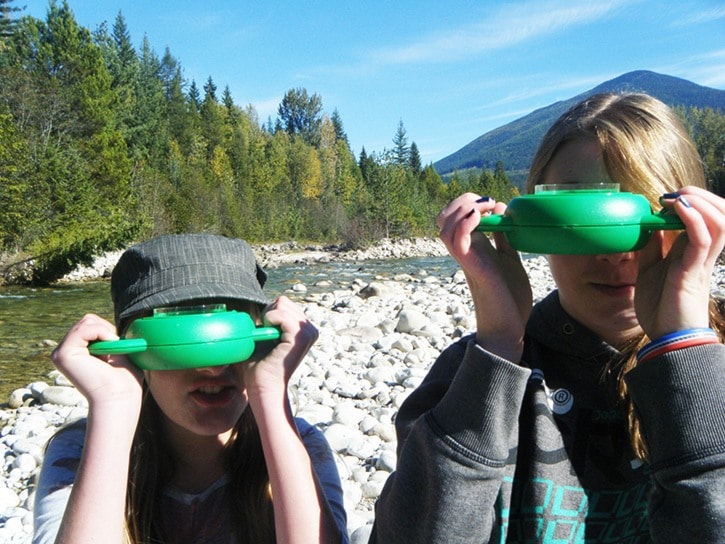For the last three years around the Columbia Basin, students have had an opportunity to find out where the water comes from that flows out their tap and goes when it’s flushed down the toilet. Thanks to a new Columbia Basin Trust program “Know Your Watershed,” young people are taken through their local water cycle from watershed to treatment plant.
In Nakusp, the tours have involved grade eight classes: this year, two classes got the tour that included a visit to the village reservoir and the sewage treatment plant, something that Public Works Manager Mike Pedersen looks forward to being a part of.
“Their enthusiasm and sincere interest is always refreshing. The sewer lagoons are the highlight of the day, prompting many interesting queries and facial expressions,” Pedersen wrote in a staff report to CAO Linda Tynan.
“Mike Pedersen has been awesome, coming on almost every trip,” commented Marcy Mahr, who is an educator for the program. She teaches the Know Your Watershed curriculum in Nakusp, New Denver and Slocan City, and she loves it.
“We’re reaching a lot of kids,” she said, “This is our biggest year as far as classes and schools.”
As a scientist, Mahr enjoys teaching research and hypothesis testing, getting kids out into the watershed and connecting classroom lessons with their everyday surroundings.
The first day is spent learning about water and watersheds all over the planet; only three percent of water on earth is fresh water and a mere 0.03 per cent is clean, drinkable water.
“They really see it’s a finite resource,” said Mahr. “For us living in the headwaters in the Columbia Basin, although we can scoop water out of creeks, the rest of the world doesn’t live this way.”
The next lesson is a hands-on day filled with activity: the students head down to the Kuskanax River to measure the water speed and take samples. Arrow Lakes Environmental Stewardship Society members Hans Dummerauf and Gary Grout have helped in the past, showing the kids how to test for temperature, conductivity, dissolved oxygen, pH, turbidity, and phosphate and nitrogen levels. Checking out the weird world of macro-invertebrates is another highlight.
“At creekside just above the Highway 6 bridge, I have students take turns donning hip waders and collecting benthic macro invertebrates with kicknet and then try to identify collected samples – caddis, stone flies, midges, etc. Gary Grout has students measure creek speed,” Dummerauf told the Arrow Lakes News, “The entire half day is quite exhausting with anywhere up to 40-some students, but we look forward to a heck of a fun time in a learning experience.”
Getting out and seeing where the water comes from, where it goes and how it’s used also teaches the kids that the water cycle is one of the great cycles of life.
“We live in our watershed, animals live in our watershed,” said educator Mahr. “It’s that integrated vision of a landscape that is important for an understanding of the landscape that’s more ecological.”
The students also get to see people working with water as careers, something they may want to pursue themselves, she noted.
“Kids get benefit from seeing people loving their work, seeing it’s not just a job,” said Rick Allen, CBT’s Environment Program Manager about students getting to interact with municipal workers as well as volunteers for different groups. “It connects them to their community too.”
“We live in an area that is extremely rich in water resources, but it won’t always be that way,” he said. “The program raises awareness in the kids, and one of the best way adults learn is through their kids.” The grade eights bring home what they learned, like that runoff from the driveway can put salt used for de-icing or phosphates used on the lawn into aquatic environments where animals will be affected.
When the tour is done, students discuss water quality, the work that goes into ensuring that clean water comes out of the tap, and water conservation. The kids then come up with action projects centring on what they’ve learned. In Fernie, CBT funded a project to paint all storm sewers to remind people that everything that goes down the drain affects fish.
After three years, the program is still developing, and Allen hopes to bring more to it in years to come.
“The program is developing; as we go it may be focusing more on the science aspect of it because that’s what holds [the students’] interest,” said Allen, who emphasized CBT was pleased to be able to facilitate the program.
“We had a bit of a hole in the school system,” he said in discussion about the origin of the program. “We were looking for a program that would address issues around water and educate kids about water in their community.”
Know Your Watershed, which now enables 19 classes in all six of the Basin’s school districts, has been the solution.
